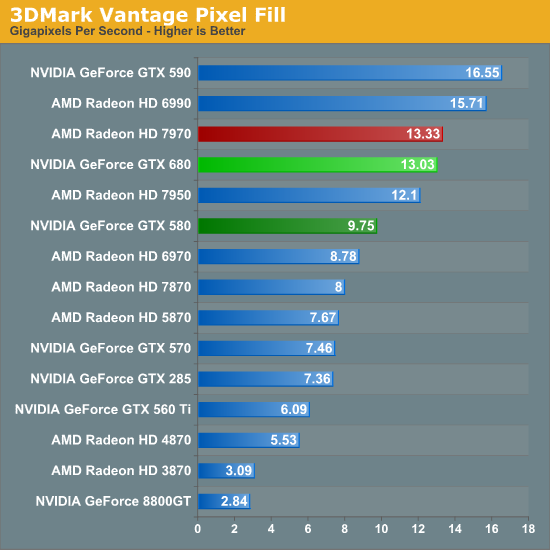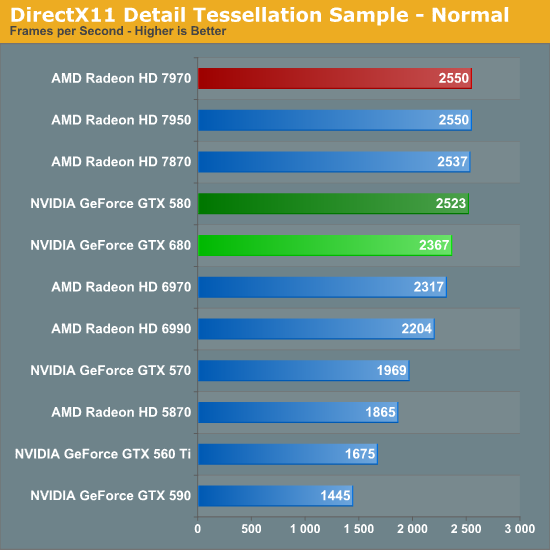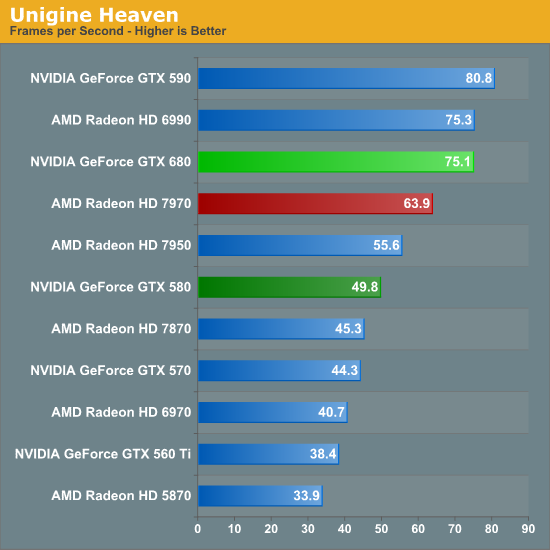NVIDIA GeForce GTX 680 Review: Retaking The Performance Crown
by Ryan Smith on March 22, 2012 9:00 AM ESTTheoreticals
As with any new architecture, we want to take a few moments to look at theoretical performance. These numbers shouldn’t be taken too seriously for cross-vendor comparison, but these numbers often tell us more about interesting architectural improvements that occur from one generation to the next.

Our first theoretical test is perhaps the most perplexing: 3DMark Vantage’s pixel fill test. Typically this test is memory bandwidth bound as the nature of the test has the ROPs pushing as many pixels as possible with as little overhead as possible, which in turn shifts the bottleneck to a mix of ROP performance and the memory bandwidth needed to feed those ROPs.
Compared to the GTX 580, the GTX 680 has almost exactly the same amount of memory bandwidth (192GB/sec) and only 86% of the theoretical ROP performance (37Gpix vs. 32Gpix). In short, it shouldn’t outperform the GTX 580 here, and yet it outperforms the 580 by 33%.
Why does it do this? That’s the hard thing to answer. As we mentioned in our look at GK104’s architecture, NVIDIA did make some minor incremental improvements to their ROPs coming from GF114, such as slightly improved compression and improved polygon merging. One of those may very well be the contributing factor, particularly the compression improvements since this is a typically memory bandwidth bottlenecked test. Alternatively, it’s interesting to note that the difference between the two video cards is almost identical to the difference in the core clock. GTX 560 Ti’s results tend to blow a hole in this theory, but it bears consideration.
In any case, it’s an interesting turn of events and hopefully one that isn’t simply an edge case. As we’ve seen in our benchmarks GTX 680 has strong performance – even if its lead compared to the 7970 diminishes with resolution – but compared to the GTX 580 in particular it needs strong ROP performance across all games in order to deliver good performance at high resolutions and anti-aliasing.

Our second theoretical test is 3DMark Vantage’s texture fill test, which to no surprise has the GTX 680 handily clobbering all prior NVIDIA cards. NVIDIA’s inclusion of 128 texture units on GK104 versus 64 on their previous generation GPUs gives the GTX 680 far better texturing performance. The 30%+ core clock difference only serves to further widen the gap.


Our third theoretical test is the set of settings we use with Microsoft’s Detail Tessellation sample program out of the DX11 SDK. Overall while NVIDIA didn’t make any significant changes to their tessellation hardware (peak triangle rate is still 4/cycle), they have been working on further improving performance at absurdly high tessellation factors. You can see some of this in action at the max factor setting, but even then we’re running into a general performance wall since the Detail Tessellation program can’t go to the absolute highest tessellation factors NVIDIA’s hardware supports.

Our final theoretical test is Unigine Heaven 2.5, a benchmark that straddles the line between a synthetic benchmark and a real-world benchmark as the engine is licensed but no notable DX11 games have been produced using it yet. In any case the Heaven benchmark is notable for its heavy use of tessellation, which means it’s largely a proxy test for tessellation performance. Here we can see the GTX 680 shoot well ahead of the GTX 580 – by more than we saw in the DX11 Detail Tessellation sample – but at the same time there’s a lot more going on in Heaven than just tessellation.
Honestly at this point in time I’m not sure just how much more tessellation performance is going to matter. Until DX11 is the baseline API for games, tessellation is still an add-on feature, which means it’s being used to add fine detail to specific models rather than being used on everything in a game world. This demands good tessellation at high factors but at the same time it’s subject to diminishing returns on the improvement to image quality as triangles reach single pixel sizes and smaller. To that end I’m still waiting to see the day where we see tessellation scale similarly to textures – that is by using full MIP chaining of displacement maps – at which point we can evaluate tessellation performance similar to texture performance when it comes to both measuring the performance hit and evaluating the difference in image quality.










404 Comments
View All Comments
jospoortvliet - Thursday, March 22, 2012 - link
Seeing on other sites, the AMD does overclock better than the NVIDIA card - and the difference in power usage in every day scenario's is that NVIDIA uses a few more watts in idle and a few less under load.I'd agree with my dutch hardware.info site which concludes that the two cards are incredibly close and that price should determine what you'd buy.
A quick look shows that at least in NL, the AMD is about 50 bucks cheaper so unless NVIDIA lowers their price, the 7970 continues to be the better buy.
Obviously, AMD has higher costs with the bigger die so NVIDIA should have higher margins. If only they weren't so late to market...
Let's see what the 7990 and NVIDIA's answer to that will do; and what the 8000 and 700 series will do and when they will be released. NVIDIA will have to make sure they don't lag behind AMD anymore, this is hurting them...
theartdude - Thursday, March 22, 2012 - link
Late to market? with Battlefield DLC, Diablo III, MechWarrier Online (and many more titles approaching), this is the PERFECT TIME for an upgrade, btw, my computer is begging for an upgrade right now, just in time for summer-time LAN parties.CeriseCogburn - Tuesday, March 27, 2012 - link
GTX680 overclocks to 1,280 out of the box for an average easy attempt...http://www.newegg.com/Product/Product.aspx?Item=N8...
See the feedback bro.
7970 makes it to 1200 if it's very lucky.
Sorry, another lie is 7970 oc's better.
CeriseCogburn - Tuesday, March 27, 2012 - link
So you're telling me the LIGHTNING amd card is cheaper ? LOLFurther, if you don't get that exact model you won't get the overclocks, and they got a pathetic 100 on the nvidia, which noobs surpass regularly, then they used 2dmark 11 which has amd tessellation driver cheating active.... (apparently they are clueless there as well).
Furthermore, they declared the Nvidia card 10% faster overall- well worth the 50 bucks difference for your generic AMD card no Overclocked LIghtning further overclocked with the special vrm's onboard and much more expensive... then not game tested but benched in amd cheater ware 3dmark 11 tess cheat.
Reaper_17 - Thursday, March 22, 2012 - link
i agree,blanarahul - Tuesday, March 27, 2012 - link
Mr. AMD Fan Boy then you should compare how was AMD doing it since since the HD 5000 Series.6970= 880 MHz
GTX 580=772 MHz
Is it a fair comparison?
GTX 480=702 MHz
HD 5870=850 Mhz
Is it a fair compaison?
According to your argument the NVIDIA cards were at a disadvantage since the AMD cards were always clocked higher. But still the NVIDIA cards were better.
And now that NVIDIA has taken the lead in clock speeds you are crying like a baby that NVIDIA built a souped up overclocked GK104.
First check the facts. Plus the HD 8000 series aren't gonna come so early.
CeriseCogburn - Friday, April 6, 2012 - link
LOL+1
Tell 'em bro !
(fanboys and fairness don't mix)
Sabresiberian - Thursday, March 22, 2012 - link
Yah, I agree here. Clearly, once again, your favorite game and the screen size (resolution) you run at are going to be important factors in making a wise choice.;)
Concillian - Thursday, March 22, 2012 - link
"... but he's correct. The 680 does dominate in nearly every situation and category."Except some of the most consistently and historically demanding games (Crysis Warhead and Metro 2033) it doesn't fare so well compared to the AMD designs. What does this mean if the PC gaming market ever breaks out of it's console port funk?
I suppose it's unlikely, but it indicates it handles easy loads well (loads that can often be handled by a lesser card,) but when it comes to the most demanding resolutions and games, it loses a lot of steam compared to the AMD offering, to the point where it goes from a >15% lead in games that don't need it (Portal 2, for example) to a 10-20% loss in Crysis Warhead at 2560x.
That it struggles in what are traditionally the most demanding games is worrisome, but, I suppose as long as developers continue pumping out the relatively easy to render console ports, it shouldn't pose any major issues.
Eugene86 - Thursday, March 22, 2012 - link
Yes, because people are really buying both the 7970 and GTX680 to play Crysis Warhead at 2560x.... :eyeroll:Nobody cares about old, unoptimized games like that. How about you take a look at the benchmarks that actually, realistically, matter. Look at the benches for Battlefield 3, which is a game that people are actually playing right now. The GTX680 kills the 7970 with about 35% higher frame rates, according to the benchmarks posted in this review.
THAT is what actually matters and that is why the GTX680 is a better card than the 7970.